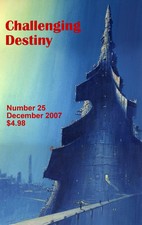


Challenging Destiny Home
What's New
Read a Copy
Issues
Stories
Reviews
Interviews
Editorials
Review of Challenging Destiny
Number 10, July 2000
This review is by Rich Horton, from Black Gate (Vol. 1 No. 2, Summer 2001). It appears here with the permission of the editor and author.
Challenging Destiny, #10
Edited by David M. & Robert P. Switzer
July 2000; 120 pages, $6
home.golden.net/~csp/previews/
Review by Rich Horton
Challenging Destiny is an attractively presented small press Canadian SF magazine. Besides six stories (two of novelette length, which is nice as many small press publications frown on longer stories), there is a thematically organized review column (this issue review some New Wave material from the late 60s), and an interview with the fine Canadian writer Candas Jane Dorsey. It has a generous selection of artwork, as well.
One of the ways for a small press publication to distinguish itself is to publish quirkier fiction: stories that might be too strange for the more mainstream magazines, or indeed stories that aren't fully successful, but which are worth attention because of their oddness. I think that's pretty much the case with my favorite two stories in this issue. "Lost in the Moid" by Hugh Cook is about a teenaged girl named Ida Brahma whom we meet wandering on a distant planet. She's being followed by an AI camera, who plans to make a record of her death in the "moid" and sell it to the network. The "moid" seems to be a system of transporters, which take one more or less randomly from planet to planet. So far that sounds a bit grim, but actually the story is light in tone, as Ida avoids dangers and thirst and rape and hopes to find her way to an inhabited planet while arranging for sufficient product placements so that she can make money from the camera's recording. All the while her discussions with the camera result in a satirical commentary on consumerism and the media-driven society. Pretty decent stuff.
Another light story is "Franklin Out," by Matthew J. Reynolds. Reynolds presents two very strange ideas. A pair of co-workers have agreed not to allow speech in their office for 5 years: they communicate only by email and instant messaging. Franklin, the stranger of this pair, hates vacations, until he encounters an outfit which offers him his idea of a perfect vacation. I'll not reveal the secret, but it's clever and wacky, and the story takes it to its logical conclusion. This is a decent story, too, though the characters were a bit flat, and the two ideas not that well integrated. Still, solid stuff.
The remainder of this issue's offerings are rather disappointing. To get the worst out of the way first, the longest story here is "Demon in the Seas" by Nye Marnach, and it is quite poor. We go from silly ideas (such as aliens who look like Angels and Demons (wow! originality!), to strange plotting (incidents mentioned that we never see, as if the story was hastily cut, and a meandering resolution that has little to do with the questions raised earlier), to bad characterization, and teeth-grinding prose (including any number of names with apostrophes, always a bad sign), and cap things off with absurd science--sorry, this piece really didn't work for me at all. Karina Sumner-Smith's "How to Kill the Sun" has a rather stridently presented situation (the ozone layer is gone, and even seconds in the sun will burn your skin dangerously), and a mystical to the point of absurd "solution" (a child trapping "coldness" and sending it to the Sun), but it's well-enough written, and is intermittently interesting. Not very good, but tolerable. "The Dragon Laureate" by Chris Webb presents a group of people encountering a dragon who likes literature. They must tell a story to escape being eaten. The story they tell is fairly interesting, with the expected relevance to the real situation, though the twist ending was not very satisfying. I'd call this one OK. Finally, David Chato's "Elias Pin Returns to Nature in the Garden of New Eden" is an allegorical story with some original features, supporting another rather strident theme. Elias Pin lives in the ultra pure and clean subdivision of New Eden, where even grass is suspect, but one day Nature takes things into its own hands. Again, this was OK, redeemed by its originality.
The stories in this issue are definitely a mixed bag, ranging from pretty solid to awful. The features are good. This is worth a look for those who like to explore the more obscure alleyways of the SF publishing field.
Last modified: August 14, 2001
Copyright © 2001 by New Epoch Press